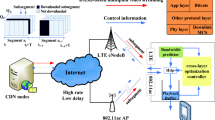Abstract
Nomadic users of streamed multimedia content in mobile networks are often faced with resource-constrained network paths that suffer from low bandwidth. Streaming high-quality video in such a challenging scenario demands a set of highly adaptive schemes, which have not been sufficiently explored in particular for the emerging H.264 Scalable Video Coding (H.264/SVC) standard. In this paper, we empirically investigate the performance of streaming H.264/SVC scalable video streams to users in multihomed mobile networks containing multiple available transmission paths. Previous work has demonstrated the feasibility of aggregating bandwidth of multiple paths to deliver video streams when no single, sufficiently high bandwidth path is available. We focus on evaluating the enhanced performance of multipath bandwidth-aggregation streaming by exploiting a quality-layers based, H.264/SVC-specific packet prioritisation scheme for quality-aware multipath packet scheduling and selective packet dropping in case of bandwidth shortage even after aggregation. Additionally, we explore a base-layer rate control scheme for H.264/SVC delivery in ultra-low bandwidth environments. Through extensive experimentation on a realistic hardware-based testbed, we obtain a comprehensive and insightful understanding of the behaviour of H.264/SVC streams when transmitted across multiple paths in mobile networks. We quantify the improvements offered by the use of H.264/SVC-specific packet prioritisation schemes compared with an existing generic scalable video prioritisation scheme, and the benefits by the use of base-layer rate control in ultra-low bandwidth situations. The performance of the multipath streaming schemes is further compared with that of an ideal single high bandwidth path. We also identify the remaining challenges that must be overcome if such streaming schemes are to offer performance close to that of the ideal single high bandwidth path.




















Similar content being viewed by others
References
Amonou I, Cammas N, Kervadec S, Pateux S (2007) Optimized rate-distortion extraction with quality layers in the scalable extension of H.264/AVC. IEEE Trans Circ Syst Video Technol 17:1186–1193
Chebrolu K, Rao R (2004) Selective frame discard for interactive video. In Proc 2004 IEEE Int Conf Commun (ICC)
Chebrolu K, Rao R (2006) Bandwidth aggregation for real-time applications in heterogeneous wireless networks. IEEE Trans Mobile Comput 5:388–403
Cicalo S, Haseeb A, Tralli V (2012) Fairness-oriented multi-stream adaptation using scalable video coding. Signal Process: Image Commun. doi:10.1016/j.image.2012.01.005
Devarapalli V, Wakikawa R, Petrescu A, Thubert P (2005) Network mobility (NEMO) basic support protocol. RFC 3963
Fernandez J, Taleb T, Guizani M, Kato N (2009) Bandwidth aggregation-aware dynamic QoS negotiation for real-time video streaming in next-generation wireless networks. IEEE Trans Multimed 11:1082–1093
Jurca D, Frossard P (2007) Video packet selection and scheduling for multipath streaming. IEEE Trans Multimed 9:629–641
Leontaris A, Tourapis AM (2007) Rate control reorganization in joint model reference software. ISO/IEC JTC1/SC29/WG11 and ITU-T SG16/Q6, Doc. JVT-W042
Li KG, Pan F, Lim KP et al (2003) Adaptive basic unit layer rate control for JVT. ISO/IEC JTC1/SC29/WG11 and ITU-T SG16/Q6, Doc. JVT-G012
Maani E, Kataggelos AK (2010) Unequal error protection for robust streaming of scalable video over packet lossy networks. IEEE Trans Circ Syst Video Technol 20:407–416
Nightingale J, Wang Q, Grecos C (2010) Optimized transmission of H.264 scalable video streams over multiple paths in mobile networks. IEEE Trans Consum Electron 56:2161–2169
Nightingale J, Wang Q, Grecos C (2011) Performance evaluation of scalable video streaming in multihomed mobile networks. ACM Perform Eval Rev 39:29–31
Nur G, Arachchi HK, Dogan S, Kondoz AM (2012) Seamless video access for mobile devices by content-aware utility-based adaptation. Multimed Tools Appl. doi:10.1007/s11042-012-1120-2
Reichel J, Schwarz H, Wien M (2007) Joint Scalable Video Model 11(JSVM 11). Joint Video Team, Doc. JVT-X202
Sanchez Y et al (2012) Efficient HTTP-based streaming using scalable video coding. Signal Process: Image Commun 27:329–342
Schwarz H, Marpe D, Wiegand T (2007) Overview of the scalable video coding extension of the H.264/AVC standard IEEE Trans. Circuits Syst. Video Technol 17:1103–1120
Taubman D (2000) High performance scalable image compression with EBCOT. IEEE Trans Image Process 9:158–1170
Tsai M et al (2010) Multi-path transmission control scheme combining aggregation and packet scheduling for real-time streaming in multi-path environment. IET Commun 4:937–945
Wang Q et al (2009) QoS-aware network-supported architecture to distribute application flows over multiple network interfaces for B3G users. Wirel Pers Commun 48:113–140
Weingand T, Sullivan G, Bjontegaard G, Luthra A (2003) Overview of the H.264/AVC video coding standard. IEEE Trans Circ Syst Video Technol 13:560–576
Wenger S, Wang YK, Schierl T, Eleftheriadis A (2011) RTP payload format for scalable video coding. RFC 6090
Wireshark. http://www.wireshark.org/. Accessed 15 November 2011
Author information
Authors and Affiliations
Corresponding author
Rights and permissions
About this article
Cite this article
Nightingale, J., Wang, Q. & Grecos, C. Empirical evaluation of H.264/SVC streaming in resource-constrained multihomed mobile networks. Multimed Tools Appl 70, 2011–2035 (2014). https://doi.org/10.1007/s11042-012-1219-5
Published:
Issue Date:
DOI: https://doi.org/10.1007/s11042-012-1219-5




